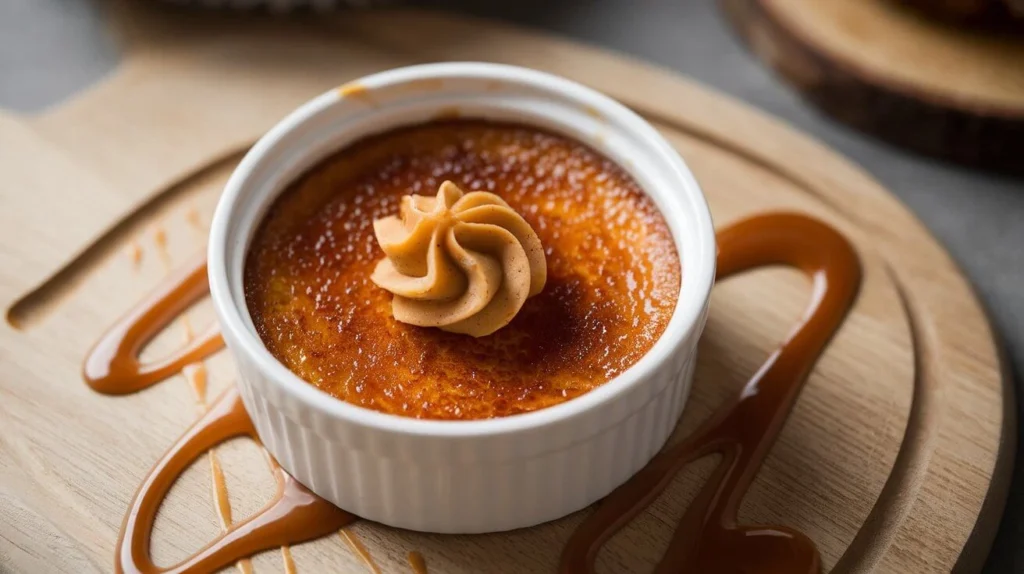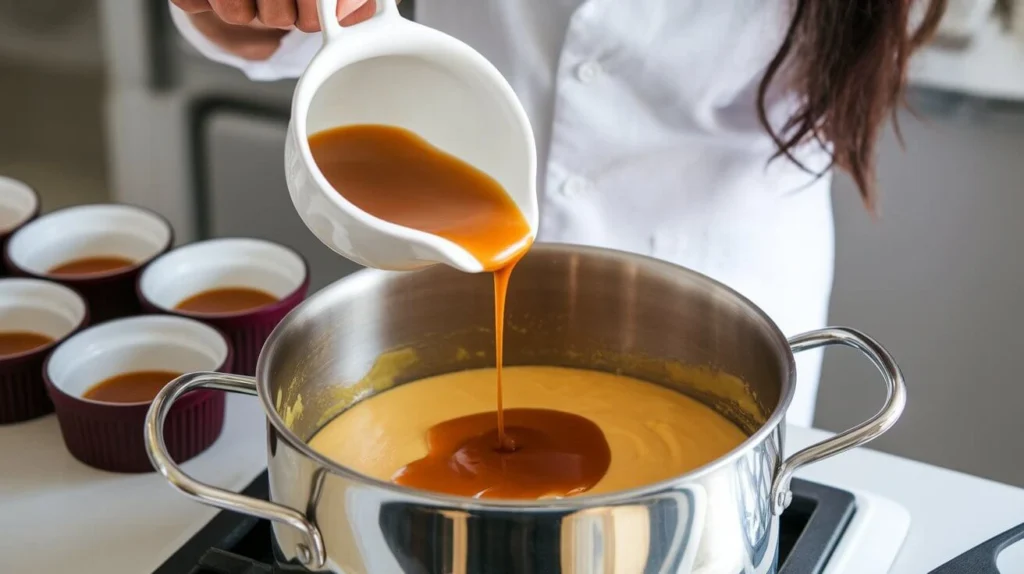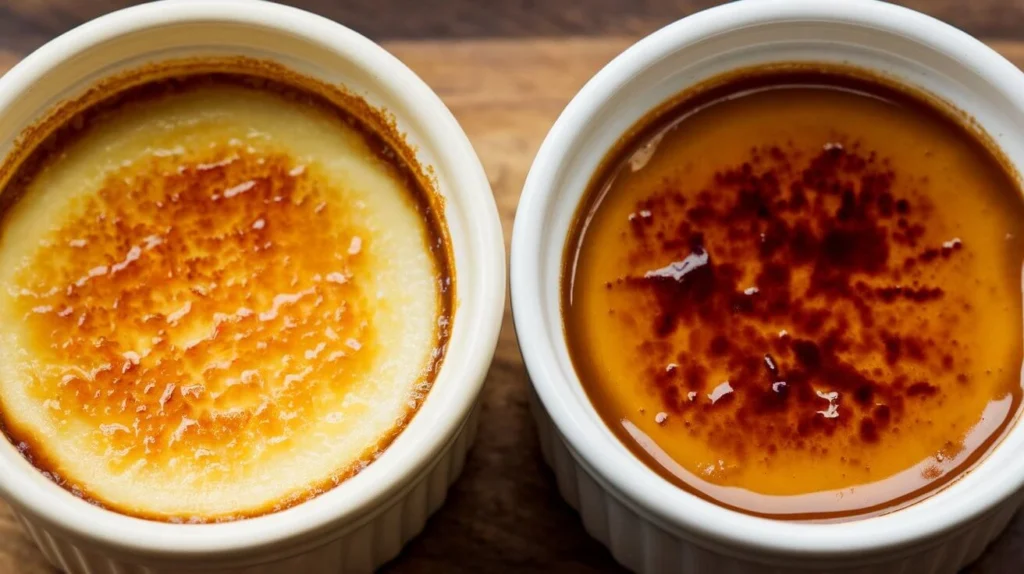This article explores the key differences in flavor, texture, and preparation between crème brûlée vs caramel brûlée
Desserts often symbolize indulgence and joy, and few can match the elegance of crème brûlée and caramel brûlée. These two custard-based treats, with their luxurious textures and caramelized sugar tops, are frequently mistaken for one another. While they may seem similar at first glance, each dessert has unique characteristics that set it apart, from their ingredients to their flavor profiles.
Crème brûlée, steeped in centuries of French tradition, is celebrated for its creamy custard base and crisp caramelized sugar crust. On the other hand, caramel brûlée, a modern twist on the classic, incorporates caramel directly into the custard, creating a dessert with a richer, more intense flavor.
In this article, we’ll explore the differences between crème brûlée and caramel brûlée, examining their origins, ingredients, preparation methods, and textures. Whether you’re a dessert enthusiast or simply curious about what makes these iconic treats distinct, this guide will provide all the answers you need.
Table of contents
What is Crème Brûlée?
A Timeless French Classic
Crème brûlée, translating to “burnt cream” in French, is a hallmark of French cuisine. Its history dates back to the 17th century and is often associated with the height of sophisticated dining. The dessert is celebrated for its creamy custard base and the signature caramelized sugar crust that provides a delightful contrast in texture.
In the battle of crème brûlée vs caramel brûlée, crème brûlée stands out for its classic vanilla-flavored custard and crisp sugar crust.
Ingredients of Crème Brûlée
The classic recipe calls for:
- Heavy cream
- Egg yolks
- Granulated sugar
- Vanilla extract or vanilla bean
The simplicity of these ingredients underscores the dessert’s elegance. The richness of the cream, combined with the egg yolks, creates a custard that is both smooth and luxurious.
Preparation Method
- Heat the heavy cream with vanilla to infuse flavor.
- In a separate bowl, whisk egg yolks and sugar until pale and creamy.
- Slowly incorporate the heated cream into the egg mixture to temper it.
- Strain the mixture and pour it into ramekins.
- Bake the ramekins in a water bath at a low temperature until the custard sets.
- Once chilled, sprinkle sugar on top and caramelize it using a kitchen torch or broiler.
Key Characteristics
- Texture: Silky, melt-in-your-mouth custard with a brittle sugar crust.
- Flavor: Mildly sweet with aromatic vanilla undertones.
- Serving Style: Served in shallow ramekins to maximize the caramelized sugar topping.
What is Caramel Brûlée?
A Modern Indulgence
Caramel brûlée is a contemporary take on crème brûlée, offering a richer and more pronounced flavor profile. While crème brûlée derives its flavor from vanilla, caramel brûlée incorporates caramel into the custard base itself. This addition results in a dessert that’s slightly denser and boasts a deep, toffee-like sweetness.
When comparing crème brûlée vs caramel brûlée, caramel brûlée incorporates caramel into the custard, creating a richer and sweeter dessert.

Ingredients of Caramel Brûlée
The primary ingredients include:
- Heavy cream
- Egg yolks
- Granulated sugar (with part of it caramelized)
- Optional: Coffee, sea salt, or additional caramel sauce for garnish
Preparation Method
- Begin by caramelizing sugar in a saucepan until it reaches a golden amber color.
- Gradually whisk in heavy cream to create a smooth caramel mixture.
- Temper the caramel mixture with whisked egg yolks and sugar.
- Strain and pour the custard into ramekins.
- Bake in a water bath at a low temperature until set.
- Chill, then finish with a caramelized sugar topping.
Key Characteristics
- Texture: Creamy and slightly denser than crème brûlée.
- Flavor: Rich caramel tones with a pronounced sweetness.
- Serving Style: Often garnished with caramel drizzle or a pinch of salt to balance the sweetness.

A Historical Perspective
The Origins of Crème Brûlée
Crème brûlée’s origins are debated. Some attribute it to France, while others claim it first appeared in England as “burnt cream” or in Spain as “crema catalana.” Regardless of its origins, the dessert gained widespread popularity in the 19th century, particularly in French fine dining.
The Evolution of Caramel Brûlée
Caramel brûlée is a more modern creation, likely inspired by the growing popularity of caramel as a flavor in desserts. Its bold and indulgent profile appeals to those seeking a twist on the classic crème brûlée.
Comparing Crème Brûlée and Caramel Brûlée
Ingredients and Flavor
The most significant difference lies in the custard base. Crème brûlée features a neutral, vanilla-forward custard, while caramel brûlée incorporates caramel, infusing the dessert with a deeper, more intense flavor.
Texture and Density
- Crème Brûlée: Light and silky, almost airy in texture.
- Caramel Brûlée: Slightly denser due to the caramel integration.

Sweetness Levels
Caramel brûlée tends to be sweeter because of the added caramel, while crème brûlée maintains a more balanced flavor profile.
Visual Presentation
Crème brûlée typically boasts a golden, glass-like sugar crust, while caramel brûlée’s custard often has a darker, richer hue due to the caramel.
Beyond taste, understanding the nutritional content of crème brûlée and caramel brûlée can help you make informed choices, whether you’re indulging occasionally or keeping track of dietary goals. Here’s a detailed comparison of their nutritional values per 100 grams:
| Nutrient | Crème Brûlée (per 100g) | Caramel Brûlée (per 100g) |
|---|---|---|
| Calories | 330 kcal | 370 kcal |
| Total Fat | 27 g | 29 g |
| Saturated Fat | 17 g | 18 g |
| Cholesterol | 230 mg | 240 mg |
| Sodium | 40 mg | 50 mg |
| Total Carbohydrates | 24 g | 30 g |
| Sugars | 22 g | 28 g |
| Protein | 4 g | 4 g |
Tips for Making Perfect Brûlée Desserts
- Use High-Quality Ingredients: Fresh cream, premium vanilla, and good-quality sugar make all the difference.
- Master the Water Bath: Baking the custards in a water bath ensures even cooking and prevents the custard from curdling.
- Perfect the Caramelization: For a flawless sugar crust, use a kitchen torch and evenly sprinkle sugar across the surface.
- Chill Before Serving: Both desserts should be well-chilled before adding the sugar crust.
If you enjoy experimenting with unique dessert recipes, you might also love Mouthwatering Crab Brûlée Recipe—a surprising twist on the brûlée concept.
Popular Variations of Crème and Caramel Brûlée
Flavor Twists for Crème Brûlée
- Chocolate Crème Brûlée: Adds a layer of richness with melted chocolate.
- Lavender Crème Brûlée: Infused with dried lavender for floral notes.
- Citrus Crème Brûlée: Incorporates orange or lemon zest for a zesty twist.
Unique Takes on Caramel Brûlée
- Coffee Caramel Brûlée: Infused with espresso for a bittersweet balance.
- Salted Caramel Brûlée: A touch of sea salt enhances the caramel’s depth.
- Spiced Caramel Brûlée: Features warm spices like cinnamon or nutmeg.
Frequently Asked Questions
Is Crème Brûlée Always Vanilla-Flavored?
Traditionally, yes, but it can be customized with flavors like chocolate, citrus, or spices.
Is Caramel Brûlée Sweeter Than Crème Brûlée?
Yes, the caramel in the custard base makes caramel brûlée noticeably sweeter.
Can I Use a Broiler Instead of a Torch?
Both desserts can be caramelized under a broiler, though a torch provides more precision.
Which Dessert is Easier for Beginners?
Crème brûlée is simpler since caramel brûlée requires the additional step of making caramel.
Are Both Desserts Naturally Gluten-Free?
Yes, both are naturally gluten-free when made with traditional ingredients.
How Long Can These Desserts Be Stored?
Both can be refrigerated for up to 3 days, but the sugar crust should be added just before serving.
Which Dessert is Right for You?
When choosing between crème brûlée and caramel brûlée, personal preferences and occasions often play a crucial role. Both desserts are rich, creamy, and indulgent, but their distinct characteristics may appeal to different tastes and settings.
When to Choose Crème Brûlée
- For Traditional Elegance: Crème brûlée’s subtle vanilla flavor and silky texture make it perfect for those who appreciate classic, understated desserts.
- Light and Balanced: If you prefer a dessert that’s not overly sweet, crème brûlée offers a more delicate balance of flavors.
- Fine Dining or Formal Occasions: Its long-standing association with French cuisine makes crème brûlée a staple for formal meals or celebratory dinners.
When to Choose Caramel Brûlée
- For Bold Flavors: Caramel brûlée’s deeper, richer profile is ideal for those who enjoy intense caramel notes.
- A Sweet Indulgence: With its slightly higher sweetness, caramel brûlée is a great option for satisfying a serious sweet tooth.
- Casual or Experimental Settings: Perfect for exploring modern takes on classic desserts, caramel brûlée adds a creative twist to any meal.
Pairing Suggestions
Both desserts can be elevated with complementary pairings:
- Crème Brûlée: Pair with a light dessert wine like Sauternes or fresh berries for added freshness.
- Caramel Brûlée: Enjoy with a bold coffee, espresso, or even a salted caramel latte for a flavor symphony.
Conclusion
Crème brûlée and caramel brûlée may seem like close relatives, but their differences make each a unique experience. Crème brûlée offers a refined, elegant dessert with subtle vanilla notes and a delicate balance of flavors. Caramel brûlée, by contrast, is bold, indulgent, and perfect for those who love the deep, rich sweetness of caramel.
Both desserts share a luxurious creaminess and the delightful crunch of caramelized sugar, making them crowd-pleasers at any occasion. Whether you’re savoring the classic or the contemporary, each bite is a testament to the artistry of custard-based desserts.
Whether you prefer the light elegance of crème brûlée or the bold indulgence of caramel brûlée, the choice in the debate of crème brûlée vs caramel brûlée ultimately depends on your personal taste.

